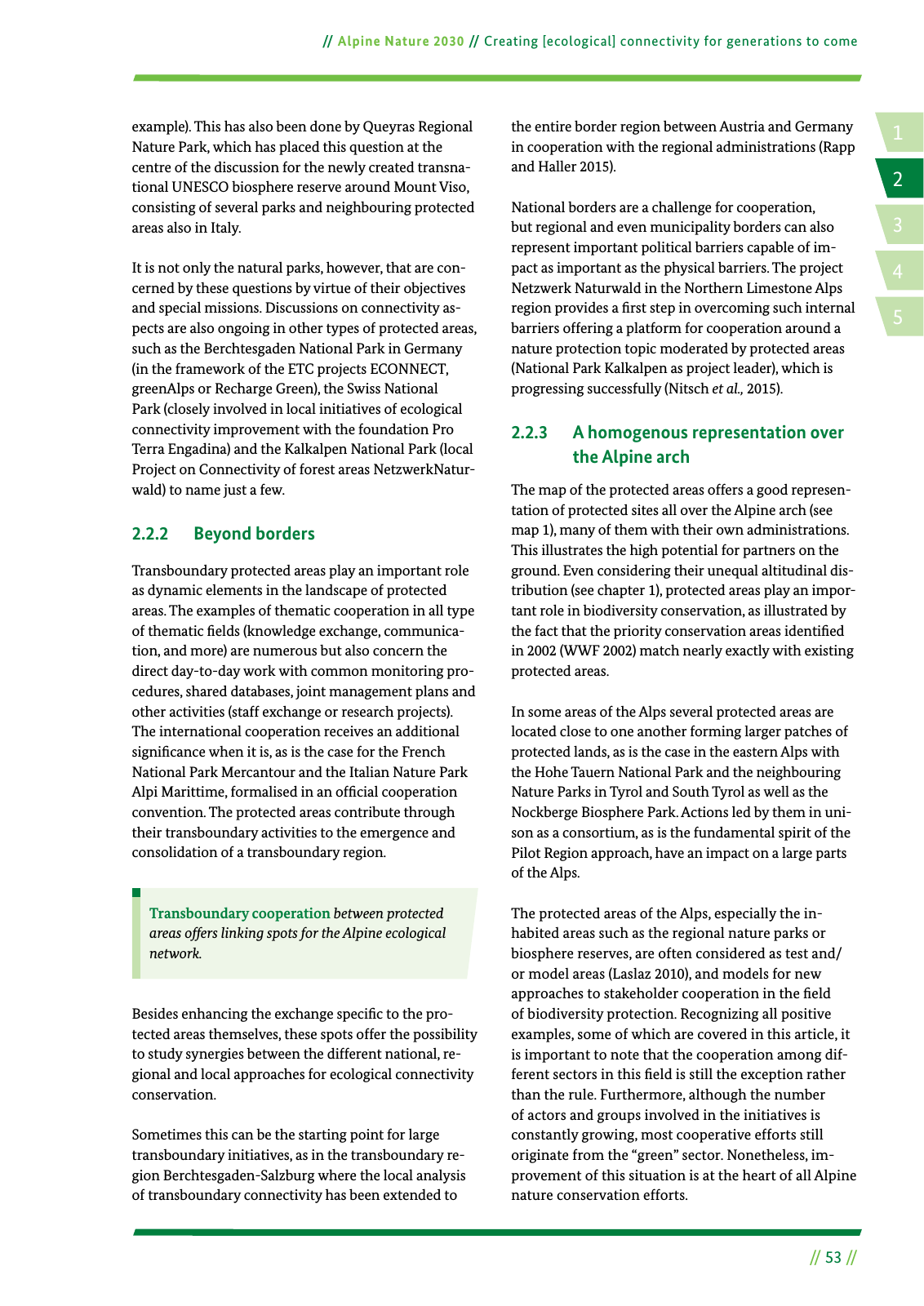14 2 5 3 53 Alpine Nature 2030 Creating ecological connectivity for generations to come example This has also been done by Queyras Regional Nature Park which has placed this question at the centre of the discussion for the newly created transna tional UNESCO biosphere reserve around Mount Viso consisting of several parks and neighbouring protected areas also in Italy It is not only the natural parks however that are con cerned by these questions by virtue of their objectives and special missions Discussions on connectivity as pects are also ongoing in other types of protected areas such as the Berchtesgaden National Park in Germany in the framework of the ETC projects ECONNECT greenAlps or Recharge Green the Swiss National Park closely involved in local initiatives of ecological connectivity improvement with the foundation Pro Terra Engadina and the Kalkalpen National Park local Project on Connectivity of forest areas NetzwerkNatur wald to name just a few 2 2 2 Beyond borders Transboundary protected areas play an important role as dynamic elements in the landscape of protected areas The examples of thematic cooperation in all type of thematic elds knowledge exchange communica tion and more are numerous but also concern the direct day to day work with common monitoring pro cedures shared databases joint management plans and other activities staff exchange or research projects The international cooperation receives an additional signi cance when it is as is the case for the French National Park Mercantour and the Italian Nature Park Alpi Marittime formalised in an of cial cooperation convention The protected areas contribute through their transboundary activities to the emergence and consolidation of a transboundary region Transboundary cooperation between protected areas offers linking spots for the Alpine ecological network Besides enhancing the exchange speci c to the pro tected areas themselves these spots offer the possibility to study synergies between the different national re gional and local approaches for ecological connectivity conservation Sometimes this can be the starting point for large transboundary initiatives as in the transboundary re gion Berchtesgaden Salzburg where the local analysis of transboundary connectivity has been extended to the entire border region between Austria and Germany in cooperation with the regional administrations Rapp and Haller 2015 National borders are a challenge for cooperation but regional and even municipality borders can also represent important political barriers capable of im pact as important as the physical barriers The project Netzwerk Naturwald in the Northern Limestone Alps region provides a rst step in overcoming such internal barriers offering a platform for cooperation around a nature protection topic moderated by protected areas National Park Kalkalpen as project leader which is progressing successfully Nitsch et al 2015 2 2 3 A homogenous representation over the Alpine arch The map of the protected areas offers a good represen tation of protected sites all over the Alpine arch see map 1 many of them with their own administrations This illustrates the high potential for partners on the ground Even considering their unequal altitudinal dis tribution see chapter 1 protected areas play an impor tant role in biodiversity conservation as illustrated by the fact that the priority conservation areas identi ed in 2002 WWF 2002 match nearly exactly with existing protected areas In some areas of the Alps several protected areas are located close to one another forming larger patches of protected lands as is the case in the eastern Alps with the Hohe Tauern National Park and the neighbouring Nature Parks in Tyrol and South Tyrol as well as the Nockberge Biosphere Park Actions led by them in uni son as a consortium as is the fundamental spirit of the Pilot Region approach have an impact on a large parts of the Alps The protected areas of the Alps especially the in habited areas such as the regional nature parks or biosphere reserves are often considered as test and or model areas Laslaz 2010 and models for new approaches to stakeholder cooperation in the eld of biodiversity protection Recognizing all positive examples some of which are covered in this article it is important to note that the cooperation among dif ferent sectors in this eld is still the exception rather than the rule Furthermore although the number of actors and groups involved in the initiatives is constantly growing most cooperative efforts still originate from the green sector Nonetheless im provement of this situation is at the heart of all Alpine nature conservation efforts

Hinweis: Dies ist eine maschinenlesbare No-Flash Ansicht.
Klicken Sie hier um zur Online-Version zu gelangen.
Klicken Sie hier um zur Online-Version zu gelangen.